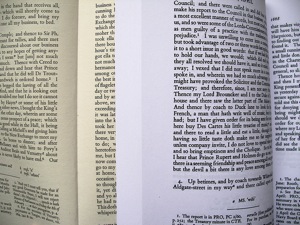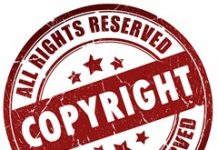Phil Gyford, who amongst many other things curates the excellent and veritable http://www.pepysdiary.com/, is rightfully annoyed at HarperCollins for pulling a bait-and-switch with their print-on-demand reissues:

The new volume, again on the right, is much whiter. It’s only when you compare standard books with really white paper that you realise they’re usually a bit yellow, slightly textured. You might think that having whiter, smoother paper is an improvement. It’s cleaner, brighter, more contrasty, but… it feels cheap. The paper is smooth and crisp, like the kind of paper you buy in reams to feed through your temperamental inkjet printer. […] Then there’s the printing. Like the cover, there’s something slightly off about it. Not only does the paper look like slick office paper, but the printing looks like it’s been churned through an office photocopier. It looks like a photocopy of the original.
… and there’s a lot more. But his point is a wider one, and bears repeating:
When publishers appear to love their own books so little, when they’re apparently happy to pass off a print-on-demand photocopy of a book as a full-price volume, it’s hard for the reader in turn to feel much love for these gradually disappearing objects.
I want to love books, but if the publisher treats them merely as interchangeable units, where the details don’t matter so long as the bits, the “content”, is conveyed as cheaply as possible, then we may be falling out of love.
I wrote about the shoddy use of POD back in 2008. Well look, the customers have noticed.
And, just as they’ve noticed this, so they’ve noticed the increased tendency of books to fall apart because they’re glued rather than stitched, and they’re starting to notice how badly-produced most ebooks are: poor OCR, bad proofing, little error correction, little or no attention to typography.
The publishing industry is happy to crow about how much it loves books, but it doesn’t often look like that to the consumer. Technologies which should be attracting more readers are being badly used to make a fast buck, and putting them off. If we lose the trust of readers, at this most critical of junctures, we will never regain it.
Photograph by Phil Gyford, licensed under Creative Commons.

































I believe Mr Gyford’s emotional connection with books is of really no interest to me or anyone that is moving to the reading on eDevices.
I do share his distaste for super white paper, but only because I find it a strain to read. I don’t want to love any book or eDevice – I want to love the writing, the writing and only the writing. If the book is legible and clear and easy to read then he should get on with reading it and stop getting obsessed with the medium….
“And I have to say, I have met Joe Fox, who owns Foxbooks, and I have heard him compared his store to a Price Club and the books in it to cans of olive oil.”
Maybe I’m weird, but I far prefer the greater contrast of higher-quality, thicker, white paper used in most trade paperbacks (including POD) over the gray newsprint-quality paper used in mass market paperbacks. Part of why offset printing of mass market paperbacks costs less is that they use cheaper paper. How is an offset print run less of a “photocopy” than POD? It’s just a different kind of photocopy machine that makes more copies at once.
That being said, the print did look more “smudged” on the POD version, hopefully something that POD printers will continue to improve.
David I have not seen a POD book as yet .. 🙂 but clearly it is only a function of the printer quality the manufacturer choses to use. It may also be a function of where in the cycle of the ‘ink’ cycle, so perhaps with some manufacturers a POD book that is printed almost at the end of a cycle is susceptible to being of lesser quality.
POD has been discussed here often, though not much recently. I believe POD has a huge future.
Howard, you’re probably right, and I know there are variations in quality among POD producers and perhaps even depending on the particular book being printed (the type of machine it’s printed on, the ink level in that machine, etc.). But, having seen a fair number of POD examples (including ordering boxes of my own books to sell), I can say the quality is generally as good or better than your average bookstore book. (Part of that is my personal preference for the whiter, thicker paper.) I’ve seen plenty of books from the bookstore (especially mass market paperbacks) with pages printed at odd angles, off-center with almost no margins on one or more sides, smudged print, very light print on a few pages, off-centered covers, etc.
Since I do essentially all my reading on the Kindle now, poor printing isn’t as big a problem for me. =) But I agree that POD will be a great technology to cost-effectively bridge the gap between the all-print world and the mostly-digital world.